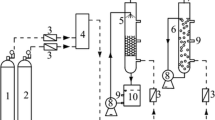Abstract
A horizontal biotrickling filter (HBTF) was used to inoculate autotrophic sulfide-oxidizing and ammonia-oxidizing microbial consortiums over H2S-exhausted carbon for co-treating H2S and NH3 waste gas in a long-term operation. In this study, several aspects (i.e., pH change, shock loading and starvation) of the dynamic behavior of the HBTF were investigated. The metabolic products of N and S bearing species in recycling liquid and biological activities of the biofilm were analyzed to explain the observed phenomena and further explore the fundamentals behind. In the pH range of 4–8.5, although the removal efficiencies of H2S and NH3 remained 96–98% and 100%, respectively, the metabolic products demonstrated different removal mechanisms and pathways. NH4-N and NO2/NO3-N were dominated at pH ≤6 and ≥7, respectively, indicating the differentiated contributions from physical/chemical adsorption and bio-oxidation. Moreover, the HBTF demonstrated a good dynamic stability to withstand shock loadings by recovering immediately to the original. During shock loading, only 15.4% and 17.9% of captured H2S and NH3 was biodegraded, respectively. After 2, 11, and 48 days of starvation, the HBTF system reached a full performance within reasonable re-startup times (2–80 h), possibly due to the consumption of reduced S and N species in biomass or activated carbon thus converted into SO4-S and NO3-N during starvation period. The results helped to understand the fundamental knowledge by revealing the effects of pH and transient loadings linked with individual removal mechanism for H2S and NH3 co-treatment in different conditions.





Similar content being viewed by others
References
Abumaizar RJ, Kocher W, Smith EH (1998) Biofiltration of BETX contaminated air streams using compost-activated carbon filter media. J Hazard Mater 60:111–126
APHA (1999) Standard methods for the examination of water and wastewater. American Public Health Association, Washington DC, USA
Chung YC, Lin YY, Tseng CP (2005) Removal of high concentration of NH3 and coexistent H2S by biological activated carbon (BAC) biotrickling filter. Bioresour Technol 96:1812–1820
Cox HHJ, Deshusses MA (2002a) Effect of starvation on the performance and re-acclimation of biotrickling filters for air pollution control. Environ Sci Technol 36:3069–3073
Cox HHJ, Deshusses MA (2002b) Co-treatment of H2S and toluene in a biotrickling filter. Chem Eng J 87:101–110
Deshusses MA, Hamer G, Dunn IJ (1996) Transient-state behavior of a biofilter removing mixtures of vapors of MEK and MIBK from air. Biotechnol Bioeng 49:587–598
Duan HQ, Koe LCC, Yan R (2005) Treatment of H2S using a horizontal biotrickling filter based on biological activated carbon: reactor setup and performance evaluation. Appl Microbiol Biotechnol 67:143–149
Duan HQ, Koe LCC, Yan R, Chen XG (2006) Biological treatment of H2S using pellet activated carbon as a carrier of microorganisms in a biofilter. Water Res 40:2629–2636
Galera MM, Cho E, Tuuguu E, Park SJ, Lee C, Chung WJ (2008) Effects of pollutant concentration ratio on the simultaneous removal of NH3, H2S and toluene gases using rock wool-compost biofilter. J Hazard Mater 152:624–631
Hekmat D, Linn A, Stephan M, Vortmeyer D (1997) Biodegradation dynamics of aromatic compounds from waste air in a trickle-bed reactor. Appl Microbiol Biotechnol 48:129–134
Ho K-L, Chung Y-C, Tseng C-P (2008) Continuous deodorization and bacterial community analysis of a biofilter treating nitrogen-containing gases from swine waste storage pits. Bioresource Technol 99:2757–2765
Jin Y, Veiga MC, Kennes C (2005) Effects of pH, CO2, and flow pattern on the autotrophic degradation of hydrogen sulfide in a biotrickling filter. Biotechnol Bioeng 92:462–471
Kim S, Deshusses MA (2005) Understanding the limits of H2S degrading biotrickling filters using a differential biotrickling filter. Chem Eng J 113:119–126
Kim HS, Kim YJ, Chung JS, Xie Q (2002) Long-term operation of a biofilter for simultaneous removal of H2S and NH3. J Air Waste Manage 52:1389–1398
Marek J, Paca J, Gerrard AM (2000) Dynamic responses of biofilters to changes in the operating conditions in the process of removing toluene and xylene from air. Acta Biotechnol 20:17–29
Patnaik P (2003) Handbook of inorganic chemicals. McGraw-Hill, New York
Prosser JI (1989) Autotrophic nitrification in bacteria. Adv Microb Physiol 30:125–181
Shanchayan B, Parker W, Pride C (2006) Dynamic analysis of a biofilter treating autothermal thermophilic aerobic digestion offgas. J Environ Eng Sci 5:263–272
Shareefdeen Z, Singh A (2005) Biotechnology for odor and air pollution control. Springer, Berlin, Germany
Villaverde S, GarciaEncina PA, FdzPolanco F (1997) Influence of pH over nitrifying biofilm activity in submerged biofilters. Water Res 31:1180–1186
Wani AH, Branion RMR, Lau AK (1998) Effects of periods of starvation and fluctuating hydrogen sulfide concentration on biofilter dynamics and performance. J Hazard Mater 60:287–303
Wright WF, Schroeder ED, Chang DPY (2005) Regular transient loading response in a vapor-phase flow-direction-switching biofilter. J Environ Eng ASCE 131:1649–1658
Yan R, Liang DT, Tsen L, Tay JH (2002) Kinetics and mechanisms of H2S adsorption by alkaline activated carbon. Environ Sci Technol 36:4460–4466
Yang YH, Allen ER (1994) Biofiltration control of hydrogen sulfide 1. Design and operational parameters. J Air Waste Manage 44:863–868
Author information
Authors and Affiliations
Corresponding author
Rights and permissions
About this article
Cite this article
Jiang, X., Yan, R. & Tay, J.H. Transient-state biodegradation behavior of a horizontal biotrickling filter in co-treating gaseous H2S and NH3 . Appl Microbiol Biotechnol 81, 969–975 (2009). https://doi.org/10.1007/s00253-008-1759-9
Received:
Revised:
Accepted:
Published:
Issue Date:
DOI: https://doi.org/10.1007/s00253-008-1759-9




